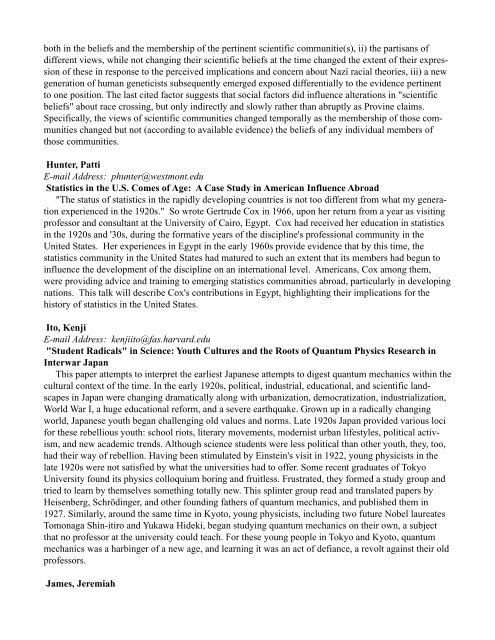Listing of Sessions and Abstracts of Papers - History of Science ...
Listing of Sessions and Abstracts of Papers - History of Science ...
Listing of Sessions and Abstracts of Papers - History of Science ...
You also want an ePaper? Increase the reach of your titles
YUMPU automatically turns print PDFs into web optimized ePapers that Google loves.
oth in the beliefs <strong>and</strong> the membership <strong>of</strong> the pertinent scientific communitie(s), ii) the partisans <strong>of</strong><br />
different views, while not changing their scientific beliefs at the time changed the extent <strong>of</strong> their expression<br />
<strong>of</strong> these in response to the perceived implications <strong>and</strong> concern about Nazi racial theories, iii) a new<br />
generation <strong>of</strong> human geneticists subsequently emerged exposed differentially to the evidence pertinent<br />
to one position. The last cited factor suggests that social factors did influence alterations in "scientific<br />
beliefs" about race crossing, but only indirectly <strong>and</strong> slowly rather than abruptly as Provine claims.<br />
Specifically, the views <strong>of</strong> scientific communities changed temporally as the membership <strong>of</strong> those communities<br />
changed but not (according to available evidence) the beliefs <strong>of</strong> any individual members <strong>of</strong><br />
those communities.<br />
Hunter, Patti<br />
E-mail Address: phunter@westmont.edu<br />
Statistics in the U.S. Comes <strong>of</strong> Age: A Case Study in American Influence Abroad<br />
"The status <strong>of</strong> statistics in the rapidly developing countries is not too different from what my generation<br />
experienced in the 1920s." So wrote Gertrude Cox in 1966, upon her return from a year as visiting<br />
pr<strong>of</strong>essor <strong>and</strong> consultant at the University <strong>of</strong> Cairo, Egypt. Cox had received her education in statistics<br />
in the 1920s <strong>and</strong> '30s, during the formative years <strong>of</strong> the discipline's pr<strong>of</strong>essional community in the<br />
United States. Her experiences in Egypt in the early 1960s provide evidence that by this time, the<br />
statistics community in the United States had matured to such an extent that its members had begun to<br />
influence the development <strong>of</strong> the discipline on an international level. Americans, Cox among them,<br />
were providing advice <strong>and</strong> training to emerging statistics communities abroad, particularly in developing<br />
nations. This talk will describe Cox's contributions in Egypt, highlighting their implications for the<br />
history <strong>of</strong> statistics in the United States.<br />
Ito, Kenji<br />
E-mail Address: kenjiito@fas.harvard.edu<br />
"Student Radicals" in <strong>Science</strong>: Youth Cultures <strong>and</strong> the Roots <strong>of</strong> Quantum Physics Research in<br />
Interwar Japan<br />
This paper attempts to interpret the earliest Japanese attempts to digest quantum mechanics within the<br />
cultural context <strong>of</strong> the time. In the early 1920s, political, industrial, educational, <strong>and</strong> scientific l<strong>and</strong>scapes<br />
in Japan were changing dramatically along with urbanization, democratization, industrialization,<br />
World War I, a huge educational reform, <strong>and</strong> a severe earthquake. Grown up in a radically changing<br />
world, Japanese youth began challenging old values <strong>and</strong> norms. Late 1920s Japan provided various loci<br />
for these rebellious youth: school riots, literary movements, modernist urban lifestyles, political activism,<br />
<strong>and</strong> new academic trends. Although science students were less political than other youth, they, too,<br />
had their way <strong>of</strong> rebellion. Having been stimulated by Einstein's visit in 1922, young physicists in the<br />
late 1920s were not satisfied by what the universities had to <strong>of</strong>fer. Some recent graduates <strong>of</strong> Tokyo<br />
University found its physics colloquium boring <strong>and</strong> fruitless. Frustrated, they formed a study group <strong>and</strong><br />
tried to learn by themselves something totally new. This splinter group read <strong>and</strong> translated papers by<br />
Heisenberg, Schrödinger, <strong>and</strong> other founding fathers <strong>of</strong> quantum mechanics, <strong>and</strong> published them in<br />
1927. Similarly, around the same time in Kyoto, young physicists, including two future Nobel laureates<br />
Tomonaga Shin-itiro <strong>and</strong> Yukawa Hideki, began studying quantum mechanics on their own, a subject<br />
that no pr<strong>of</strong>essor at the university could teach. For these young people in Tokyo <strong>and</strong> Kyoto, quantum<br />
mechanics was a harbinger <strong>of</strong> a new age, <strong>and</strong> learning it was an act <strong>of</strong> defiance, a revolt against their old<br />
pr<strong>of</strong>essors.<br />
James, Jeremiah
















